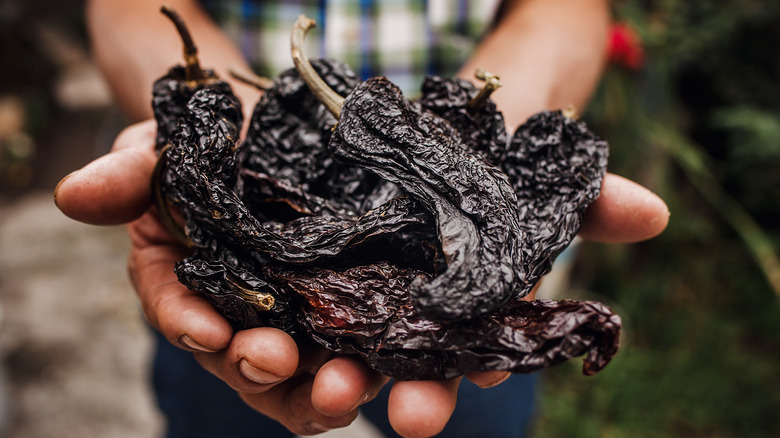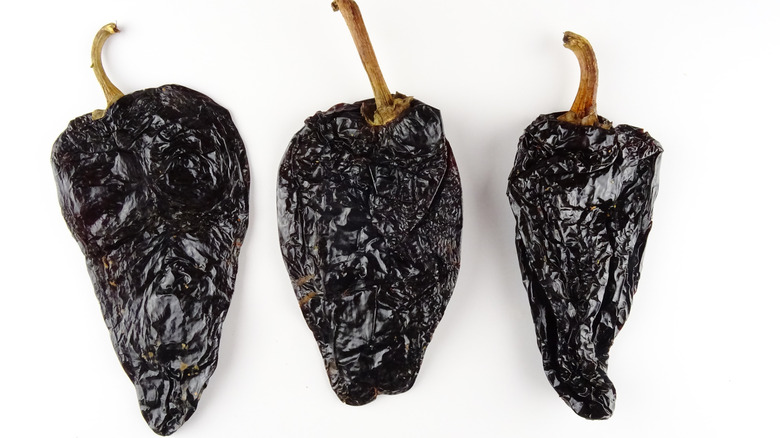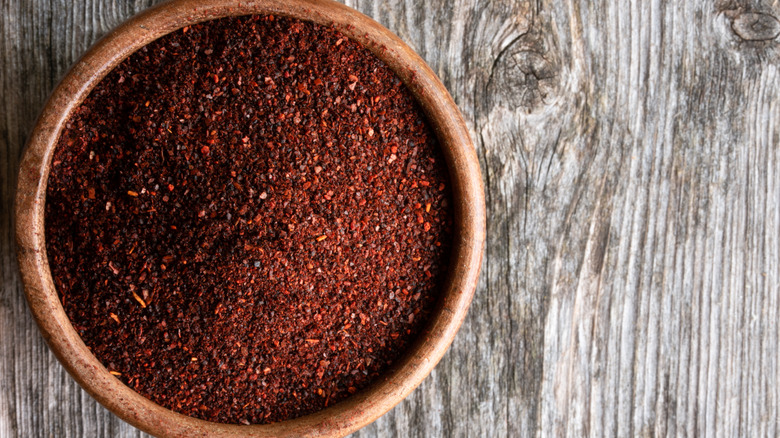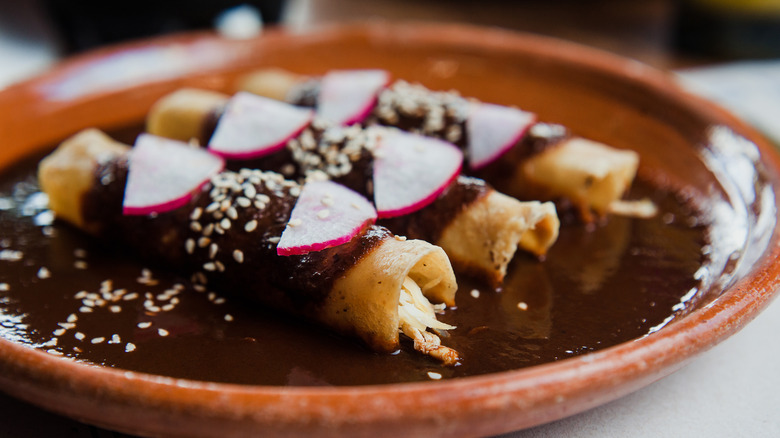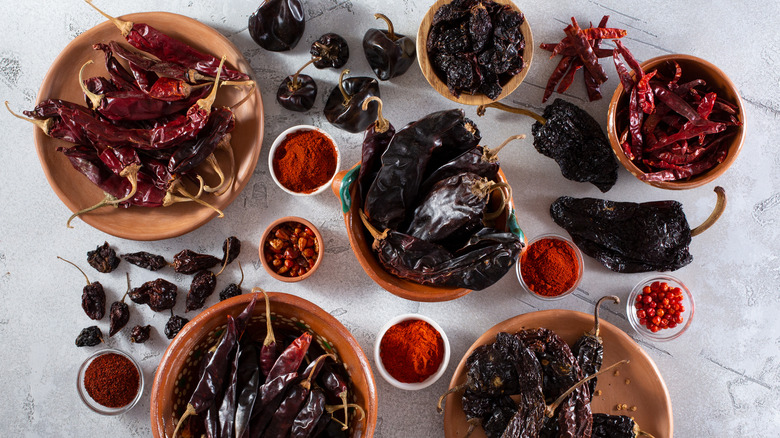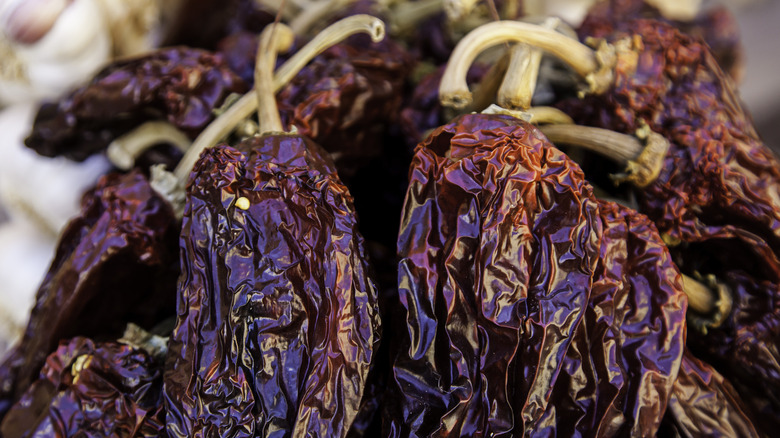What Is An Ancho Chile And How Spicy Is It?
Conjure images of Mexican food and spice is an immediate component. The nation utilizes 64 varieties of peppers, which can go into everything from salsa to hot chocolate. It's fair to say that the fruit is a cornerstone of the cuisine; it's intertwined into many of the country's dishes. And while fresh peppers do make an appearance, there are also dried varieties that are used more frequently than their fresh counterpart. Available in both whole and powdered form, they are stalwarts of Mexican kitchens and markets. With such a strong identity, oftentimes, the relationship between dried and fresh peppers isn't even readily apparent. With vastly different uses, it's not always evident jalapenos and chipotles spring from the same seed.
Such is also the case with the beloved ancho chile, which is processed from poblano peppers. One of the most reliably aromatic and convenient peppers to cook with, its mild spiciness and earthy flavor make it a pantry staple. Let's dive into this delicious dried chile — many Mexican dishes wouldn't be complete without it.
What is an ancho chile?
Ancho, meaning wide in Spanish, is a dried poblano pepper. The fresh pepper's characteristic green color is due to the fact it's typically consumed when unripened — before the skin color turns to a darker hue. During ancho production, poblano chiles are matured to a bold red color and then dried. Such a process imparts ancho's unmistakably delicious, earthy flavor.
Ancho chilies are one of Mexico's most utilized dried peppers, alongside árbol and guajillos. They are the least spicy of the three, with a Scoville ranking of 500-3,000. Combined with their rich, fleshy body, appealing color, and ultra-flavorful quality, anchos are one of the easiest peppers to integrate into foods. Rehydrated as well as powdered, many dishes rely upon their trademark flavor.
Anchos are distinct from guajillos, chipotles, and other dried varieties due to their initial pepper pre-processing. However, there is another dried variety made from poblanos — the mulato. This varietal is dried once poblanos mature to an even darker brown hue, which lends it an accompanying chocolatey flavor. While visually similar, make note that the mulato has a sweeter, smokier flavor, so don't confuse them in applications.
How to prepare ancho chilies
Ancho chilies have a raisin-like sweet and earthy quality. Their flavor includes some smokiness, coffee-like rich bitterness, and just a dollop of heat. While they can be deftly combined with other ingredients, their pungent flavor can also be overbearing, so it's necessary to handle them with care. Although not the spiciest of chilies, they do still pack some spice — so don't be surprised if there's an ancho kick.
Several preparation techniques are common to bring out their delectable flavor. The most convenient is rehydration — simply soak anchos in hot water for up to 30 minutes. The resultant pepper will be once again mushy and malleable, making it easy to grind into a paste suitable for marinades, salsas, and other sauces.
Alternatively, toast the chilies in an over or low-heated skillet to bring out a brighter, aromatic flavor. Then, chop or grind into applications like moles, soups, rubs, and slow-cooked meats. Unlike other peppers, there's no need to remove the seeds due to fear of over-spicing. However, it is helpful to discard them alongside the stems to avoid any unpleasant textures.
Dishes made with ancho chilies
Ancho chilies are one of the most utilized dried peppers in both Mexican and Tex-Mex cuisine. A star component in mole, they are one of the key elements for earthy renditions of the sauce. Their depth-inducing quality also makes them well-suited for slow-simmering dishes like beef chili, pozole, and chile colorado. And while vehicles for delectable flavor on their own, they are frequently paired with spicier dried chiles like guajillo and chipotle for a truly multi-pronged pepper flavor. For a well-known dish with a pepper medley, concoct an enchilada sauce — the bright red mixture isn't complete without a couple of anchos thrown in.
Their easy use and incredible taste also make them a popular choice for external applications. Consider an ancho rub for fish and chicken, which can later be added to burritos and tacos. In such dishes, ancho is in powdered form, an even less intensely flavored variant of the pepper. Alternatively, anchos also make for a delicious marinade, especially paired with citruses like lime and orange. In this application, rehydrate rather than use a powdered form for maximum flavor.
On top of usage in a broad range of Mexican dishes, ancho chiles can simply be used as a spice staple in the pantry. Whether it's combining them with cinnamon, cumin, and other flavors for a grilled chicken breast or even concocting a pasta or noodle dish, a hint of their earthy flavor will be a welcome addition to a variety of cuisines.
How to store and select ancho chiles
In order to easily rehydrate without any brittle components, store them in an airtight container. Away from sunlight and in a relatively dry environment, anchos will keep for upwards of six months. For an even longer shelf-life, consider freezing; in this manner, the peppers will keep for a year.
To get the longest storage time and flavor out of the pepper, make sure to select high-quality anchos. Look for whole peppers that have a deep, appetizing maroon color. Blemishes, uneven coloring, and chiles with many fragmented pieces are likely stale and are best avoided. As with other spices, let the nose be an indicator — the pepper should have a rich, earthy, and sweet aroma reminiscent of chocolate and raisins. If contained in a bag, bend the anchos to verify pliability; they should easily retain their shape. Selecting ancho powder is a little more difficult, with olfactory signals as the main determinant.
Where to buy ancho chiles
The best place to buy ancho chiles is at a Mexican market, where the vibrant peppers overflow baskets alongside other varieties. If you're located in the U.S., search for the nearest Mexican grocery, they should offer a similar selection with the best quality.
It's also possible to purchase the pepper from online purveyors, which runs a bit pricier but is still a viable option. Make sure to check for packaging dates — freshness plays a large role in the flavor of the peppers. Ancho chile powder is a little easier to find and typically more uniform in flavor. Check on the packaging that the spice is exclusively ancho peppers since it can be easy to confuse with other chili powders. While other powdered peppers also offer aromatic flavors, they do not deliver the same earthy taste as anchos. Few options will render a bad result, but there's nothing quite like a batch of whole-dried ancho chiles.
